TOYOTA T100 1998 Owners Manual
Manufacturer: TOYOTA, Model Year: 1998, Model line: T100, Model: TOYOTA T100 1998Pages: 214, PDF Size: 4.72 MB
Page 151 of 214
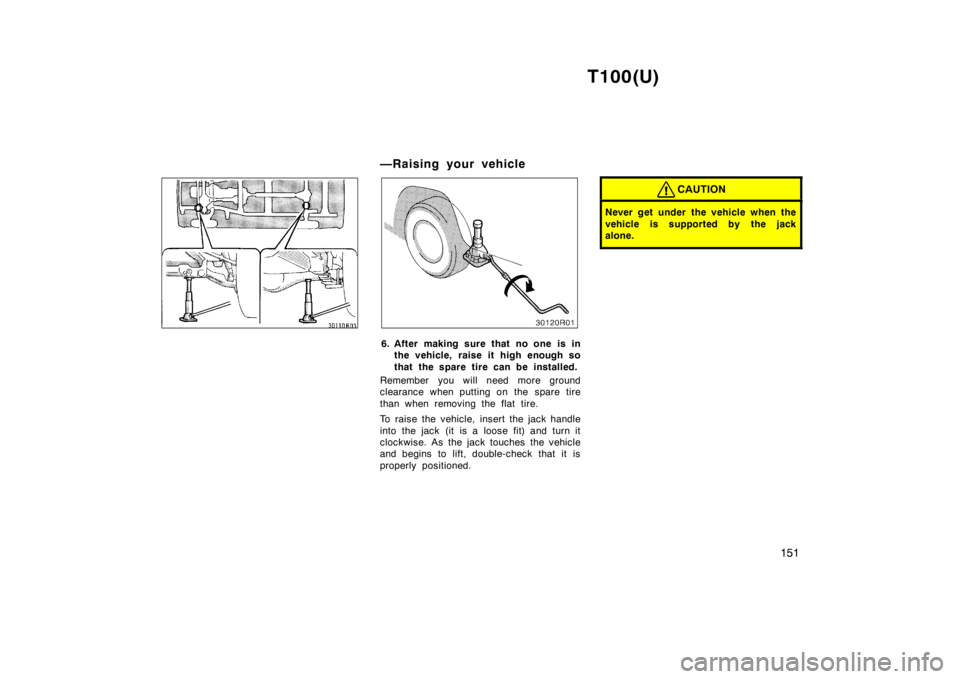
T100(U)151
—Raising your vehicle
6. After making sure that no one is inthe vehicle, raise it high enough so
that the spare tire can be installed.
Remember you will need more ground
clearance when putting on the spare tire
than when removing the flat tire.
To raise the vehicle, insert the jack handle
into the jack (it is a loose fit) and turn it
clockwise. As the jack touches the vehicle
and begins to lift, double-check that it is
properly positioned.
CAUTION
Never get under the vehicle when the
vehicle is supported by the jack
alone.
Page 152 of 214

T100(U)
152
—Changing wheels
7. Remove the wheel nuts and change
tires.
Lift the flat tire straight off and put it
aside.
Roll the spare wheel into position and
align the holes in the wheel with the bolts.
Then lift up the wheel and get at least the
top bolt started through its hole. Wiggle
the tire and press it back over the other
bolts.Before putting on wheels, remove any cor-
rosion on the mounting surfaces with a
wire brush or such. Installation of wheels
without good metal-to-metal contact at the
mounting surface can cause wheel nuts to
loosen and eventually cause a wheel to
come off while driving. Therefore after the
first 1600 km (1000 miles), check to see
that the wheel nuts are tight. —Reinstalling wheel nuts8. Reinstall all the wheel nuts finger
tight.
Reinstall the wheel nuts and tighten them
as much as you can by hand. Press back
on the tire and see if you can tighten
them more.—Lowering your vehicle
Page 153 of 214
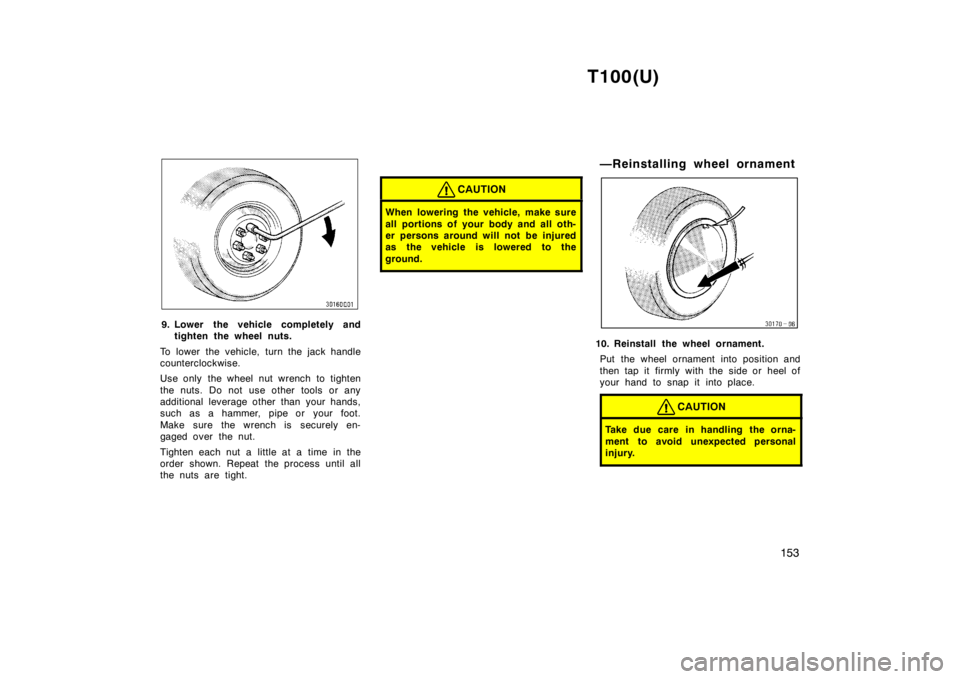
T100(U)153
9. Lower the vehicle completely andtighten the wheel nuts.
To lower the vehicle, turn the jack handle
counterclockwise.
Use only the wheel nut wrench to tighten
the nuts. Do not use other tools or any
additional leverage other than your hands,
such as a hammer, pipe or your foot.
Make sure the wrench is securely en-
gaged over the nut.
Tighten each nut a little at a time in the
order shown. Repeat the process until all
the nuts are tight.
CAUTION
When lowering the vehicle, make sure
all portions of your body and all oth-
er persons around will not be injured
as the vehicle is lowered to the
ground.
—Reinstalling wheel ornament
10. Reinstall the wheel ornament. Put the wheel ornament into position and
then tap it firmly with the side or heel of
your hand to snap it into place.
CAUTION
Take due care in handling the orna-
ment to avoid unexpected personal
injury.
Page 154 of 214
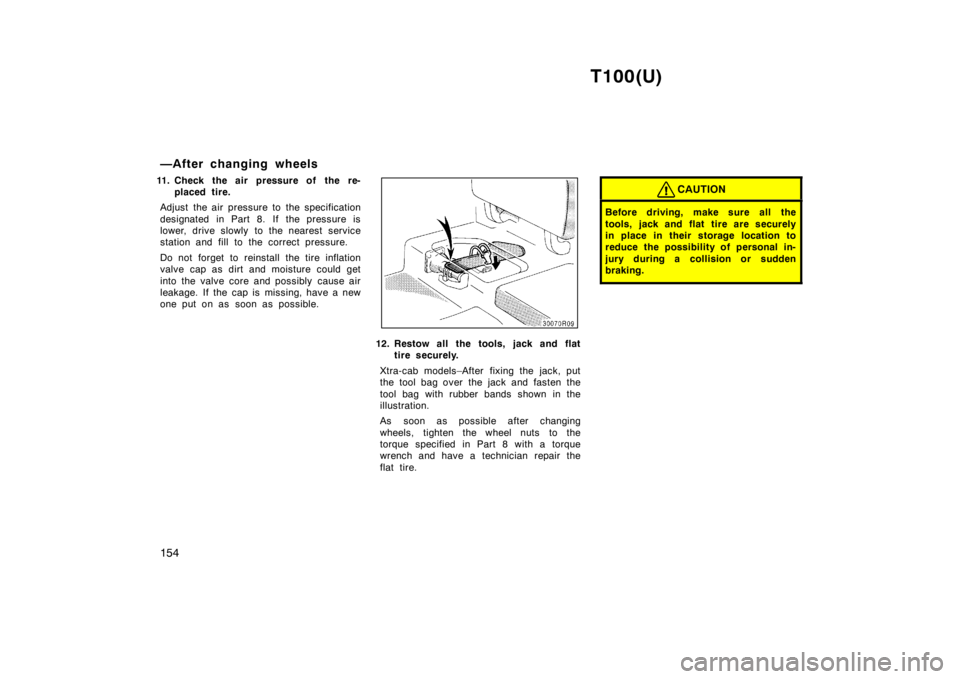
T100(U)
154
—After changing wheels
11. Check the air pressure of the re- placed tire.
Adjust the air pressure to the specification
designated in Part 8. If the pressure is
lower, drive slowly to the nearest service
station and fill to the correct pressure.
Do not forget to reinstall the tire inflation
valve cap as dirt and moisture could get
into the valve core and possibly cause air
leakage. If the cap is missing, have a new
one put on as soon as possible.
12. Restow all the tools, jack and flat tire securely.
Xtra-cab models–After fixing the jack, put
the tool bag over the jack and fasten the
tool bag with rubber bands shown in the
illustration.
As soon as possible after changing
wheels, tighten the wheel nuts to the
torque specified in Part 8 with a torque
wrench and have a technician repair the
flat tire.
CAUTION
Before driving, make sure all the
tools, jack and flat tire are securely
in place in their storage location to
reduce the possibility of personal in-
jury during a collision or s udden
braking.
Page 155 of 214

T100(U)155
If towing is necessary, we recommend
you have it done by your Toyota dealer
or a commercial tow truck service. In
consultation with them, have your ve-
hicle towed using either (a) or (b).
Only when you cannot receive a towing
service from a Toyota dealer or com-
mercial tow truck service, tow your ve-
hicle carefully in accordance with the
instructions given in ”—Emergency tow-
ing” in this Part.
Proper equipment will help ensure that
your vehicle is not damaged while being
towed. Commercial operators are generally
aware of the state/provincial and local
laws pertaining to towing.
Your vehicle can be damaged if it is
towed incorrectly. Although most operators
know the correct procedure, it is possible
to make a mistake. To avoid damage to
your vehicle, make sure the following few
precautions are observed. If necessary,
show this page to the tow truck driver.
TOWING PRECAUTIONS:
Use a safety chain system for all towing,
and abide by the state/provincial and local
laws. The wheels and axle on the ground
must be in good condition. If they are
damaged, use a towing dolly.
If your vehicle needs to be
towed—
Page 156 of 214
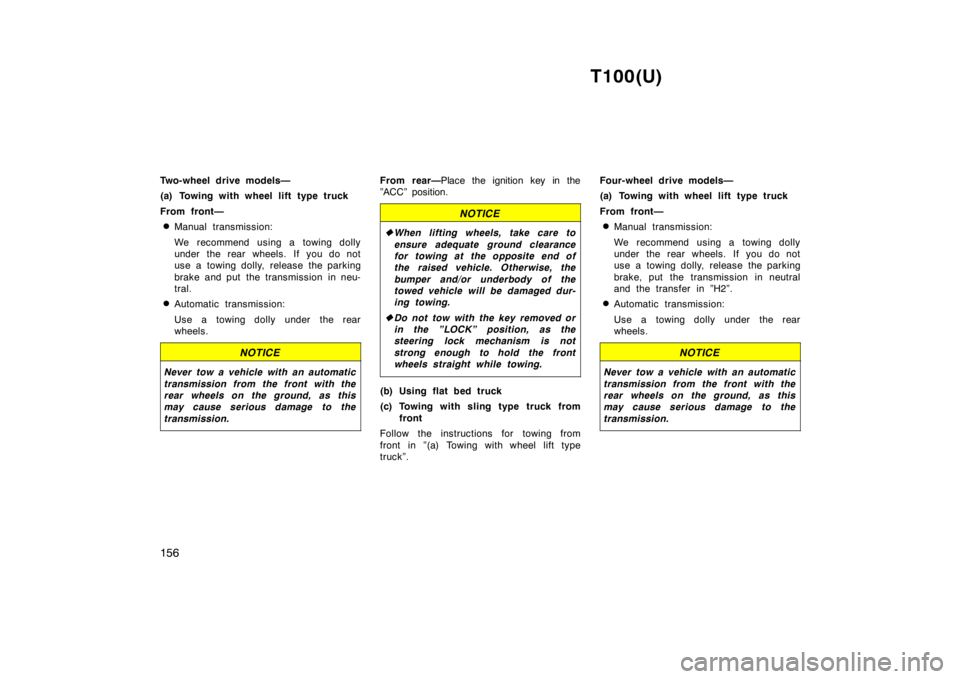
T100(U)
156
Two-wheel drive models—
(a) Towing with wheel lift type truck
From front—
� Manual transmission:
We recommend using a towing dolly
under the rear wheels. If you do not
use a towing dolly, release the parking
brake and put the transmission in neu-
tral.
� Automatic transmission:
Use a towing dolly under the rear
wheels.
NOTICE
Never tow a vehicle with an automatic
transmission from the front with the
rear wheels on the ground, as this
may cause serious damage to the
transmission.
From rear— Place the ignition key in the
”ACC” position.
NOTICE
� When lifting wheels, take care to
ensure adequate ground clearance
for towing at the opposite end of
the raised vehicle. Otherwise, the
bumper and/or underbody of the
towed vehicle will be damaged dur-
ing towing.
� Do not tow with the key removed or
in the ”LOCK” position, as the
steering lock mechanism is not
strong enough to hold the front
wheels straight while towing.
(b) Using flat bed truck
(c) Towing with sling type truck from
front
Follow the instructions for towing from
front in ”(a) Towing with wheel lift type
truck”. Four-wheel drive models—
(a) Towing with wheel lift type truck
From front—
� Manual transmission:
We recommend using a towing dolly
under the rear wheels. If you do not
use a towing dolly, release the parking
brake, put the transmission in neutral
and the transfer in ”H2”.
� Automatic transmission:
Use a towing dolly under the rear
wheels.
NOTICE
Never tow a vehicle with an automatic
transmission from the front with the
rear wheels on the ground, as this
may cause serious damage to the
transmission.
Page 157 of 214
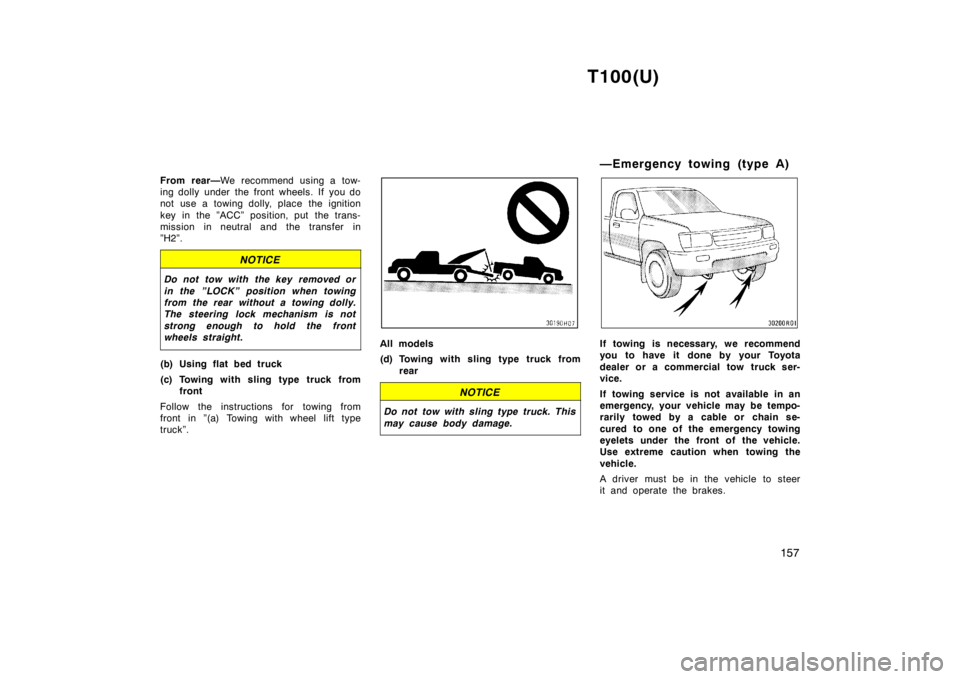
T100(U)157
From rear—
We recommend using a tow-
ing dolly under the front wheels. If you do
not use a towing dolly, place the ignition
key in the ”ACC” position, put the trans-
mission in neutral and the transfer in
”H2”.
NOTICE
Do not tow with the key removed or
in the ”LOCK” position when towing
from the rear without a towing dolly.
The steering lock mechanism is not
strong enough to hold the front
wheels straight.
(b) Using flat bed truck
(c) Towing with sling type truck from front
Follow the instructions for towing from
front in ”(a) Towing with wheel lift type
truck”.
All models
(d) Towing with sling type truck from rear
NOTICE
Do not tow with sling type truck. This
may cause body damage.
—Emergency towing (type A)
If towing is necessary, we recommend
you to have it done by your Toyota
dealer or a commercial tow truck ser-
vice.
If towing service is not available in an
emergency, your vehicle may be tempo-
rarily towed by a cable or chain se-
cured to one of the emergency towing
eyelets under the front of the vehicle.
Use extreme caution when towing the
vehicle.
A driver must be in the vehicle to steer
it and operate the brakes.
Page 158 of 214
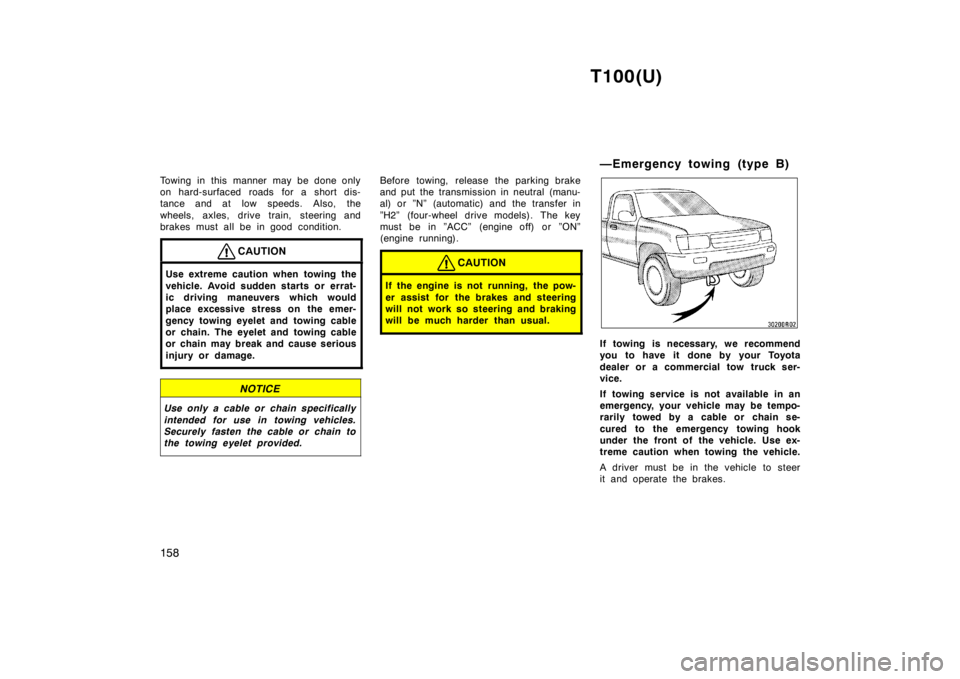
T100(U)
158
Towing in this manner may be done only
on hard-surfaced roads for a short dis-
tance and at low speeds. Also, the
wheels, axles, drive train, steering and
brakes must all be in good condition.
CAUTION
Use extreme caution when towing the
vehicle. Avoid sudden starts or errat-
ic driving maneuvers which would
place excessive stress on the emer-
gency towing eyelet and towing cable
or chain. The eyelet and towing cable
or chain may break and cause serious
injury or damage.
NOTICE
Use only a cable or chain specifically
intended for use in towing vehicles.
Securely fasten the cable or chain to
the towing eyelet provided.
Before towing, release the parking brake
and put the transmission in neutral (manu-
al) or ”N” (automatic) and the transfer in
”H2” (four-wheel drive models). The key
must be in ”ACC” (engine off) or ”ON”
(engine running).
CAUTION
If the engine is not running, the pow-
er assist for the brakes and steering
will not work so steering and braking
will be much harder than usual.
—Emergency towing (type B)
If towing is necessary, we recommend
you to have it done by your Toyota
dealer or a commercial tow truck ser-
vice.
If towing service is not available in an
emergency, your vehicle may be tempo-
rarily towed by a cable or chain se-
cured to the emergency towing hook
under the front of the vehicle. Use ex-
treme caution when towing the vehicle.
A driver must be in the vehicle to steer
it and operate the brakes.
Page 159 of 214

T100(U)159
Towing in this manner may be done only
on hard-surfaced roads for a short dis-
tance and at low speeds. Also, the
wheels, axles, drive train, steering and
brakes must all be in good condition.
CAUTION
Use extreme caution when towing the
vehicle. Avoid sudden starts or errat-
ic driving maneuvers which would
place excessive stress on the emer-
gency towing hook and towing cable
or chain. The hook and towing cable
or chain may break and cause serious
injury or damage.
NOTICE
Use only a cable or chain specifically
intended for use in towing vehicles.
Securely fasten the cable or chain to
the towing eyelet provided.
Before towing, release the parking brake,
put the transmission in neutral (manual) or
”N” (automatic) and the transfer in ”H2”.
The key must be in ”ACC” (engine off) or
”ON” (engine running).
CAUTION
If the engine is not running, the pow-
er assist for the brakes and steering
will not work so steering and braking
will be much harder than usual.
�Before emergency towing, check that
the hook or eyelet is not broken or
damaged and that the installation bolts
are not loose.
� Fasten the towing cable or chain se-
curely to the hook or eyelet.
� Do not jerk the hook or eyelet. Apply
steady and even force.
� To avoid damaging the hook or eyelet,
do not pull from the side or at a verti-
cal angle. Always pull straight ahead.
—Emergency towing hook
or eyelet precautions
(four-wheel drive models)
Page 160 of 214

T100(U)
160
CAUTION
If the emergency towing hook or eye-
let is used to get out when your ve-
hicle becomes stuck in the mud, sand
or other condition from which the ve-
hicle cannot be driven out under its
own power, make sure to observe the
precautions mentioned below. Other-
wise, excessive stress will be put on
the hook or eyelet and the towing
cable or chain may break, causing
serious injury or damage. � If the towing vehicle can hardly
move, do not forcibly continue the
towing. Contact your Toyota dealer
or a commercial tow truck service
for assistance.
� Tow the vehicle as straight ahead
as possible.
� Keep away from the vehicle during
towing.
The following methods are effective to
use when your vehicle is stuck in the
mud, sand or other condition from
which the vehicle cannot be driven out
under its own power. Use extreme cau-
tion when towing the vehicle. In addi-
tion, keep away from the vehicles and
towing cable or chain when towing.
� Remove the sand and soil in the front
and the back of the tires.
� Place stones or wood under the tires. If you lose your keys
Many Toyota dealers can make a new
key if you can give them the key num-
ber.
See the suggestion given in ”Keys” in
Chapter 1
−2.
If your key is locked in the vehicle and
you cannot get a duplicate, many Toyota
dealers can still open the door for you,
using their special tools. If you must
break a window to get in, we suggest
breaking the smallest side window be-
cause it is the least expensive to replace.
Be extremely cautious to avoid cuts from
the glass.
—Tips for towing a stuck
vehicle (four
−wheel drive models)